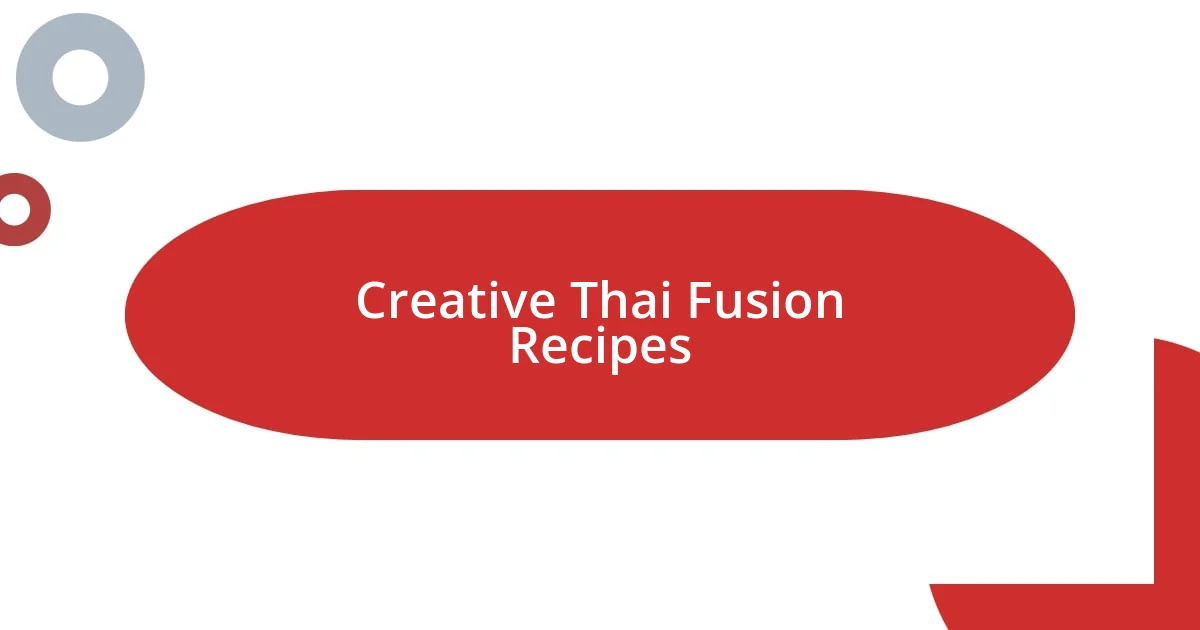Key takeaways:
- Thai fusion cuisine blends traditional Thai flavors with other culinary cultures, creating unexpected and delightful dishes.
- Understanding key ingredients and cooking techniques, such as flavor balancing and stir-frying, enhances the creative potential of Thai fusion cooking.
- Pairing drinks that complement the spices in Thai fusion dishes can elevate the overall dining experience.

Introduction to Thai Fusion Cuisine
Thai fusion cuisine is like a vibrant tapestry woven from the rich traditions of Thailand and the innovative flair of other culinary cultures. I remember the first time I tasted a Thai-infused taco; the explosion of sweet, spicy, and tangy flavors was nothing short of a revelation. Have you ever experienced a blend of tastes that took your taste buds on an unexpected journey?
For me, exploring Thai fusion cuisine feels like an adventure where each new dish tells a story. I recall experimenting with a Pad Thai-inspired pasta at home, tossing together stir-fried noodles with fresh basil and a squeeze of lime, and it was a delightful fusion I never knew I needed. Isn’t it fascinating how ingredients from one culture can enhance the identity of another?
It’s this combination of local ingredients and traditional Thai recipes that truly sets Thai fusion apart, creating delightful surprises in every bite. Embracing creativity in the kitchen not only expands our palates but also connects us to a global community through food. How has a dish inspired you to explore beyond your culinary comfort zone?

Understanding Thai Culinary Basics
When diving into Thai culinary basics, it’s important to recognize the balance of flavors that Thai cuisine is famous for. In my experience, each ingredient plays a part in creating a symphony of taste. For instance, the combination of salty, sweet, sour, and spicy can create a dish that is both complex and satisfying. I vividly remember my first time making Tom Yum soup; the harmony of lemongrass, kaffir lime leaves, and chili was a revelation. It felt like I was composing a musical score, where every note had its perfect spot.
Here are some fundamental elements to grasp:
- Herbs and Spices: Aromatic ingredients such as basil, cilantro, and lemongrass are essential.
- Flavors: The key components include salty (fish sauce), sweet (palm sugar), sour (lime juice), and spicy (fresh chilies).
- Staple Ingredients: Rice is crucial, often served alongside various dishes, acting as a base that soaks up flavor.
- Cooking Techniques: Techniques like stir-frying and steaming highlight the fresh ingredients while keeping dishes light and healthy.
- Curry Pastes: These vibrant pastes are the heart of many Thai dishes, bringing depth and richness to curries and soups.
Understanding these fundamentals has helped me appreciate the artistry behind each dish. Whether whipping up a green curry or a spicy papaya salad, these basics guide my culinary journey into Thai cuisine, encouraging creativity at every step.

Key Ingredients in Thai Fusion
When it comes to Thai fusion, the key ingredients often bridge cultures, making each dish a delightful fusion of flavors. One standout ingredient is Thai basil. I find its unique sweet and slightly peppery flavor elevates various dishes, whether in a traditional Thai curry or a modern pizza topped with Thai elements. How amazing is it that one herb can transform an everyday meal into an adventure?
Coconut milk is another essential player, adding creaminess and depth that make everything from curries to desserts taste luxurious. I remember experimenting with a coconut milk-infused risotto, where the richness and subtle sweetness brought a whole new dimension to the dish. It was a perfect example of how Thai cuisine invites others to embrace bold flavors while still feeling at home.
Moreover, traditional sauces like Nam Prik Pao, which is a roasted chili sauce, have found their way into diverse recipes beyond Thai food. Using it as a marinade or a dip creates a fusion experience that’s incredibly satisfying. Incorporating such ingredients allows for endless creativity in the kitchen, inviting personal twists on beloved dishes.
| Ingredient | Characteristics |
|---|---|
| Thai Basil | Sweet, slightly peppery, aromatic herb |
| Coconut Milk | Rich, creamy, adds depth to dishes |
| Nam Prik Pao | Roasted chili sauce, versatile flavor enhancer |

Techniques for Thai Fusion Cooking
When it comes to Thai fusion cooking, mastering techniques can set you apart. One of my favorites is the art of stir-frying. I remember my first attempt at a stir-fried pad Thai with a twist, incorporating some leftover roasted vegetables. The sizzle and aroma were intoxicating, and it reminded me of how quickly fresh ingredients can transform under high heat, creating that unique smoky flavor I crave. Have you ever watched your ingredients dance in the pan, releasing aromatic notes that fill your kitchen? That’s the magic of proper technique.
Another technique I find particularly rewarding is layering flavors through simultaneous cooking methods. For instance, combining steaming with sautéing can create dishes that are both light and complex. I once made a dish where I steamed fragrant fish and paired it with a zesty sauce, allowing the flavors to meld beautifully. This layering not only enhances the dish’s depth but also respects the integrity of each ingredient. Have you tried experimenting with different cooking methods to see how they interact? It can lead to some delightful surprises!
Lastly, incorporating elements from other cuisines while respecting traditional Thai practices is essential. I’ve dabbled in using Thai spices to make a classic Italian risotto; the warmth of cumin paired with saffron was an unexpected yet fantastic marriage of flavors. It’s in these moments of culinary curiosity that we truly embrace the spirit of fusion. What boundless options can you create when you allow yourself to play with techniques and flavors? The sky’s the limit in Thai fusion cooking.

Creative Thai Fusion Recipes
Exploring creative Thai fusion recipes has become one of my favorite culinary adventures. One time, I decided to combine my love for tacos with the bold flavors of Thai cuisine. I whipped up Thai green curry chicken tacos topped with pickled cucumbers and fresh cilantro. The moment I took a bite, the harmonious blend of spicy, tangy, and creamy flavors delighted my taste buds. Who knew my taco night could feel like a trip to Thailand?
Another standout dish I created was a tom yum soup risotto. Imagine the creamy texture of risotto infused with the fragrant notes of lemongrass, galangal, and lime. I remember stirring the pot while the enticing aroma wafted around my kitchen. It felt like a delicate dance between two worlds, and every spoonful transported me to a vibrant street food market in Bangkok. Have you ever experienced a dish that just pulled you into its story?
I also enjoy experimenting with dessert. Recently, I made a Thai mango sticky rice panna cotta. This recipe combined the silky richness of panna cotta with the classic flavors of coconut milk and fresh mango. The first taste was a burst of nostalgia, reminding me of summer trips to Thailand. It’s moments like these that keep me inspired; they remind me how fusion can evoke cherished memories and create new ones simultaneously. How do you blend your favorite flavors to tell your culinary story?

Pairing Drinks with Thai Fusion
Pairing drinks with Thai fusion dishes can elevate your dining experience to new heights. I vividly recall hosting a dinner party where I served spicy mango and shrimp spring rolls alongside a chilled Thai basil mojito. The vibrant, herbaceous notes of lime and fresh basil beautifully complemented the sweetness of the mango and the heat of the chili. Have you ever felt how a sip can enhance the nuances of a dish? It’s incredible how the right drink can round out the flavors on your plate.
When exploring beverage options, I often gravitate towards aromatic wines or craft beers that echo the spices in my dishes. One evening, I prepared a red curry-based pasta and paired it with a light, fruity Riesling. The wine’s slight sweetness contrasted perfectly with the curry’s spiciness, creating a balance that made every bite and sip memorable. I find that understanding the flavor profiles—like how sweetness can tame heat—creates those lovely moments at the table where everything just clicks.
Lastly, don’t underestimate the power of a creative cocktail to mirror the essence of your meal. For instance, when I crafted a Thai-inspired poke bowl, I served it with a coconut-infused gin cocktail. The drink’s tropical notes tied back to the flavors of the bowl, bringing a cohesive and joyful dining experience. Have you ever thought about crafting your own cocktails to complement home-cooked dishes? It’s a delightful way to extend the flavors from the plate to the glass!















